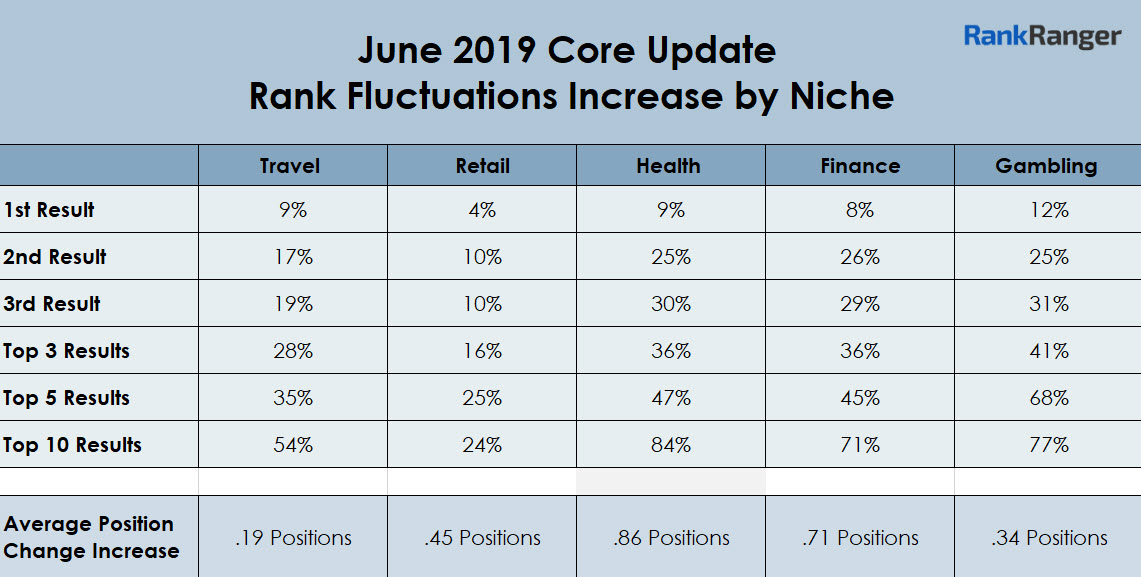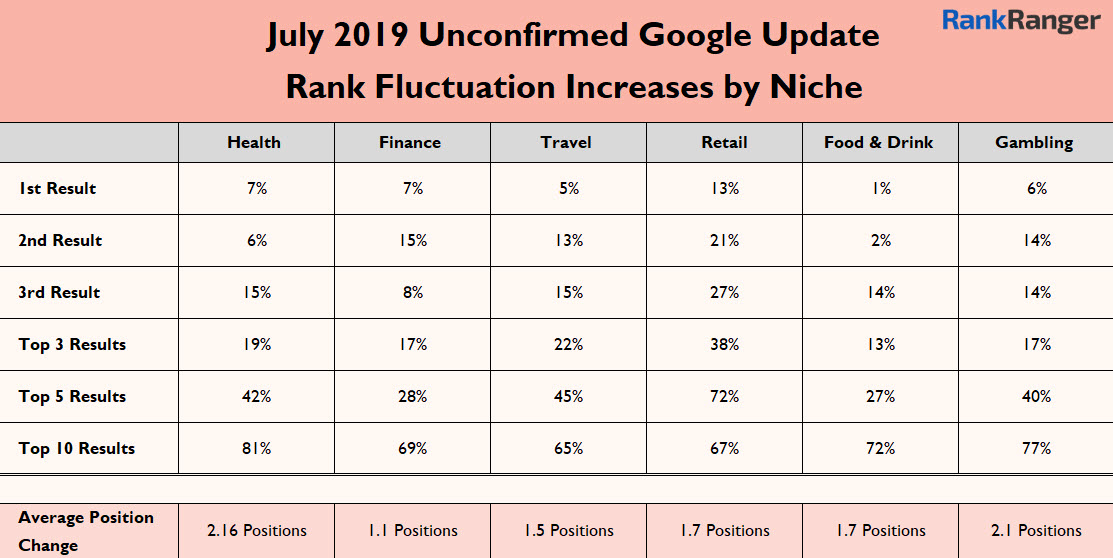Posted by
Mordy Oberstein
Almost out of nowhere, Google unleashed one of the most volatile days in SEO history. July 18th, 2019, saw an unprecedented amount of rank fluctuations unlike the industry had seen for years. Yet, the unconfirmed algorithm update left as quickly as it came when rank fluctuations returned to normal levels on a dime. It all begets the question: Who was impacted and what in the world just happened?
Here’s a look at the data on Google’s unconfirmed July 2019 algorithm update.
What Happened When Google Unleashed A Massive Algorithm Update in July 2019?
It began pretty benignly. It all seemed to be your typical run-of-the-mill update as our Rank Risk Index began seeing moderate levels of rank fluctuations on June 16th. Things continued in typical fashion on the 17th as fluctuation levels increased to slightly more severe levels. Then, and without warning, all hell broke loose on July 18th as rank fluctuations spiked to levels we had not seen in years!

Rank fluctuations on the Google SERP hit an exceedingly unusual high on July 18th
The Data on July’s Insane Levels of Rank Fluctuations
So what exactly happened? What was responsible for these extravagant levels of rank fluctuations? Was this update any different than your “normal” Google algorithm update?
A good place to start is by comparing the unconfirmed July update to the very much confirmed June 2019 Core Update. Here’s the data on how the update impacted the various niches back in June:

A couple of key things to note:
- Your Money Your Life (YMYL) niches (i.e., the Health and Finance niches) were more heavily impacted back in June than the other niches (in general)
- Outside of the YMYL niches, the fluctuations recorded, while high, were what you would expect to see during a Google update.
Compare this to the data I pulled out of the July 2019 update and a very different narrative emerges:

For starters, at the first, second, and third ranking positions, both the June core update and the unconfirmed July update seem quite similar. However, when you move down the SERP and reach position 5 and beyond, everything becomes far more volatile with the July update.
Take the Travel niche. During the June 2019 Core Update, the top 10 results overall saw a volatility increase of 54%. Compare that to the 65% I recorded during the July update. The same for the Retail niche which saw a “lowly” 24% fluctuation increase back in June but here showed a massive 67% increase in rank fluctuations.
Another way to put it is as follows: The June 2019 Core Update saw YMYL sites take a more severe “beating” with the Health and Finance niches showing far more rank fluctuations when looking at the top 10 results on the SERP. The unconfirmed July 2019 update saw the rest of the niches catch up. Here, even the Travel and Retail niches showed the same excessive rank fluctuations among the top 10 results. Meaning, the Travel and Retail niches showed the same level of fluctuations recorded among the YMYL niches back in June!
Takeaway: The extreme levels of rank fluctuations appear to be driven by rank changes to the bottom half of the SERP across all niches (not just YMYL sites). These fluctuations exceeded the levels seen during Google’s core updates for non-YMYL niches.
A World of Inconsistency: Site-Level Patterns & the July 2019 Google Update
Site-level data fresh off a Google update can be fascinating. It’s the stuff good (and some pretty bad) SEO theories are made of. The trouble with this sort of data is that it’s often anecdotal. As it is here. I cannot be clearer, the very odd and downright bizarre patterns I saw at the site-level are not 100% conclusive. Rather, they are my best assessment of what happened at the site-level and what it says about the update. In other words, I looked at a lot of data/sites, saw what I saw, found it fascinating… but it is in no way concretely conclusive (not that I think any of the site-level data out there is, ever).
Now, aren’t you just a bit curious what I saw?
The Role of Site Profiles & Authority During the July 2019 Update
The July update has to be about YMYL sites, UX/UI, and poor authority, right? Right? Wrong.
While there were certainly a nice amount of sites with what I call “profile” issues (inconsistent or poor “messaging” at all levels – content, UI, UX, etc.) I don’t think this update was about that. Yes, a lot of health sites that are less about health and more about trying to sell you magic solutions got slammed by this update. At the same time, there were a nice number of health sites that I would have thought to be demoted for having a poor UI, clickbaity content, and so forth that were instead rewarded by this update. But maybe you’ll argue that sort of thing always happens, Google isn’t perfect…
Either way, I just didn’t see the same sort of focus on authority/site profiles that came with the Medic Update and the like. While you can find instances of sites with a poor UI or misleading profiles being hit by the update, the pattern just didn’t “pop” the same way it did with other updates.
Take it or leave it, this is what I saw.
Slow Gains Trampled by the July 2019 Update
There were a nice number of sites that since the start of July were slowly and steadily showing visibility increases. With the July update, it almost seemed as if Google caught itself saying, “Wait a second, why are we increasing the rankings for this site?” And so, with one fell swoop, Google reined these sites back in, obliterating the ranking gains the sites had seen in weeks prior.
Here’s how the visibility for the site aimmune.com looks as a result of the July update:

See those nice ranking gains the site started to pick up as July 1st rolled in? Well, as is evident, a good portion of those gains are gone as a result of the July update!
Whether a site lost all of the gains seen at the start of July or just some of those rankings… there was definitely a pattern that had Google rescind its previous ranking rewards!
Quick Ranking Reversals
Part of what made this update so odd (more on that soon) were the number of sites that saw a ranking increase over the first two days of the update only to have those gains wiped out on July 18th (i.e., the day rank fluctuations went totally wild).
After looking at dozens of sites it became clear to me that there was a strong pattern where Google increased a site’s rankings at the start of the update just to take them away by the time the update was fully rolled-out.
In some instances, Google recalled just some of the rankings gains a site saw during the early part of the update while in other cases Google pulled all of a site’s ranking gains.

Yahoo Finance saw its initial rank gains pulled back some by the time the July update was fully rolled out
Very odd to see such a pattern manifest itself to a significant extent. Reversals are a normal part of the algorithm update game, but that usually happens days or weeks (or even months) later… not the next day!
The Mid-Summer Algorithmic Classic… Somethings Smells Off

I’m being a bit sarcastic with my heading here. There was not a lot that was “classic” about this update. There has been some speculation that the update’s profile perhaps aligns to something similar to a core update (with YMYL sites coming into focus along with concepts like authority and so forth). I don’t think that’s the case. I definitely don’t get the feeling that this was a core update. The site-level patterns aren’t consistent, the back and forth fluctuations from day to day, etc. just don’t “come off” like a core update.
If I could sum up the update in one word it would be “weird.” With very few exceptions, updates of this caliber don’t just stop. We don’t go from driving 100 mph (or kph) to 0 in a split second. We generally see a day (or two) of moderate rank fluctuations following an instance of extreme volatility. Not here. We see this “record high” and then bam… we go to the opposite extreme, inordinately low levels of rank fluctuations. It’s downright peculiar.
On top of that, it seems that Google just couldn’t make up its mind. First, it took sites that it boosted up since the start of July and demoted them. Then the search engine offered sites a quick jolt up the SERP only to reverse these gains the next day (in many instances).
It makes me wonder if something wasn’t going right. It makes me think that Google was not happy with some sort of change or process that it had been running and decided to touch things up a bit (or more than a bit if you look at the levels of rank fluctuations). Either that or something within this update just didn’t go as planned. As with all things anecdotal, it’s hard to qualify my sense of the situation, but something here just seems out of place. The site-level patterns were all over the place, the roll-out per se was atypical, there was a lack of an “update identity” (even more than usual)… something just doesn’t feel right about this one!
Were you looking for something more concrete? Sorry folks, sometimes a good sense of things is all you get. But as a teacher of mine used to say… not all speculation is bad speculation!

